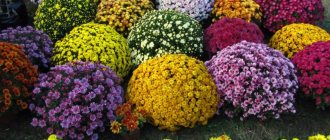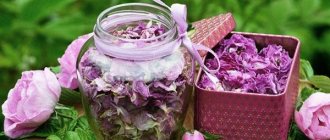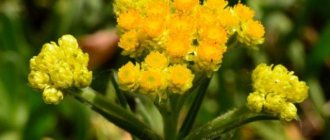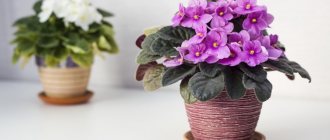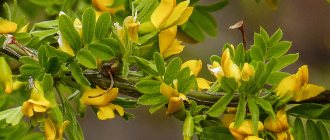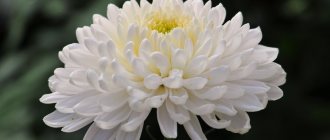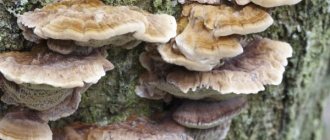- November 20, 2019
- Flowers
- Svetlana Pavlova
Chrysanthemums belong to the Asteraceae family, and the most famous variety of the flower is the Chrysanthemum daisy. It is a perennial shrub plant. Florists value it because it does not fade for a long period of time. Bouquets of these flowers decorate the house for a long time, regardless of the time of year. They are not afraid of low temperatures, so they are considered an ideal gift during the winter season.
general information
In ancient times, only flowers of yellow shades were known. Translated from ancient Greek, the name of this plant means “golden-flowered.” Chrysanthemums began to be grown back in the twelfth century in Japan and were considered a symbol of power. Members of the royal family used flowers to decorate their clothing. Currently, for the Japanese, chrysanthemum is a sign of longevity. Colored daisies are associated with mourning in some European countries. For example, in France and Italy they represent sadness. In China, various compositions are made with them. When this flower is combined with bamboo or pine, good luck and prosperity will come to the house, according to ancient belief.
What is chamomile chrysanthemum?
These are perennial shrub plants, many varieties of which grow in Asian countries, and they are also frequent guests in garden plots in our latitudes. The group of these chrysanthemums includes varieties that have inflorescences:
- non-double;
- semi-double.
They are united by a visible disc of tubular flowers. White chamomile chrysanthemum is easy to recognize among other varieties. Its flower heads resemble the well-known chamomile. This is where the name of these flowers came from. Often white varieties of chrysanthemums are confused with daisies, but there is a difference between them.
Growing problems, diseases and pests
Like other flowers, chamomile chrysanthemum can get sick. Most often she suffers from fungal diseases.
And the most common pests are:
- aphid;
- mite;
- thrips.
How to deal with them
To rid a flower of disease, drugs such as “Topaz” and “Fundazol” are used. A weakened bush can be treated with Zircon.
If pests are noticed on the plant, it should be sprayed with Fitoverm 3 times every 5 days. Aktar will help fight root pests.
Additional Information! Systemic insecticides help control insects.
Chrysanthemums that look like daisies will not leave anyone indifferent. Knowing the basic rules of care, even novice gardeners will be able to grow a beautiful and attractive flower without any difficulties.
Description of the species
In recent years, chamomile chrysanthemum has been cultivated in our country. It is represented by different varieties and hybrid forms. This is a shrubby perennial crop with delicate small flowers collected in inflorescences (simple and semi-double) umbrellas. They differ in the number of rows of marginal petals. The middle consists of tubular petals quite tightly adjacent to each other, forming a dense disk, which is a common characteristic of both semi-double and non-double varieties. According to the shape of the bush, such a chrysanthemum is divided into:
- Tree-like - a tall, erect plant with flowers of different shades - pink, white, cream, lilac and red.
- Bush is a low plant, shaped like a ball with yellowish-whitish inflorescences located on it, similar to chamomile.
Some varieties of bushes can grow up to one and a half meters in height. This species, similar to daisies, was bred from several wild varieties and is not found in nature. The plant begins to bloom with flowers from mid-July until frost, emitting a bitter aroma. Withered flowers are removed so that they do not interfere with the appearance of new ones. They decorate gardens, plots or are used to make bouquets and compositions. The large leaves are jagged, their length can reach twelve, and their width is about five centimeters. The plant prefers well-fertilized, moist soil and a sunny place. However, waterlogging and direct sunlight will negatively affect the condition of the plant. The ideal temperature for growing both outdoors and indoors is considered to be between thirteen and eighteen degrees. It is better to use a metal lattice as a support for the bush.
How do these plants differ from real daisies?
Chrysanthemums and daisies are considered relatives, since both belong to the Aster family. At the same time, it is impossible to say that this is the same plant. Chamomiles belong to the genus Matricaria and have many differences from chrysanthemums. The latter are called daisies only due to the similarity of the structure of the inflorescences, which, by the way, is characteristic of many other aster plants.
It is also useful to read: Do you need to trim chamomile for the winter and when is the best time to do it?
True daisies are annual or perennial bush plants. For example, this is what chamomile looks like:
The height of its bushes ranges from 15 to 60 cm, and the diameter of the inflorescences is only 2.5 cm. As for color, daisies are characterized by a combination of only white and yellow colors, while chrysanthemums have colored inflorescences and often consist of flowers of several shades at once.
Also, in daisies, the marginal flowers are located in only one row, while in chrysanthemums they are often arranged in several. The inflorescences of the latter are also significantly larger than chamomile ones in size. While daisies have very small flower baskets, chrysanthemums, on the contrary, practically never have such small inflorescences.
Here the photo shows inflorescences of daisies and chrysanthemums:
As you can see, the latter are much larger. These same photographs show the difference between the height and thickness of the stem, as well as the shape and density of the leaves.
This is what chamomile leaves look like up close:
And so chrysanthemums:
On a note
Chamomile inflorescences are used as medicinal raw materials and are used in both traditional and folk medicine. Chrysanthemum inflorescences have a different chemical composition and are not used for medicinal purposes.
What do different colors of chrysanthemums mean?
If you are presented with a bouquet of multi-colored daisies, then this is an expression of affection and feelings. There is a language of colors, where each tone has its own meaning:
- Pale lilac, pink - such delicate shades are most suitable for young ladies. They are given by young guys on first dates. In the language of flowers, this means the emergence of youthful love, the expression of feelings.
- Yellow – friendly devotion and declaration of love. They symbolize touching, openness and sincerity. Presenting a bouquet of yellow chamomile chrysanthemums at an official reception means a wish for prosperity and success in business.
- Burgundy, red, wine - bouquets of such rich colors are given to loved ones or when they want to confess their love.
- Whites are a sign of deep respect. They are presented when they want to emphasize the high moral qualities of an individual and his impeccability.
- Blue - such a bouquet of daisy-shaped chrysanthemums is often presented to creative individuals, as well as acquaintances or colleagues.
Varieties
Quite a few varieties are known. Here are some of them:
- Viscose - the flowers have an interesting color scheme - a lilac shade with a white border.
- Orlina - bright yellow buds. It is most often used in flower arrangements.
- Santini - used in landscape design to create colorful compositions in the garden.
- Ariel is a voluminous bush reaching a height of eighty centimeters. The inflorescences of the basket are up to twelve centimeters in diameter. The petals are elongated and whitish in color.
- Camilla is a semi-double bush chamomile chrysanthemum with white flowers and a yellowish center.
- Lunetta Orange - has an unusual coloring (salmon) of long petals along the edges and dense and small inside. The middle is greenish.
- Yellow Ring - plants of this variety are small, their height does not exceed thirty centimeters. The inflorescence is simple yellow with a green center.
- Bordeaux - flowers are bright red and burgundy, against which the greenish-yellow centers look great.
- Sleighs have a rich yellow tint that creates a joyful mood.
- Santini Tedcha - a chrysanthemum looks like a daisy with a black center and yellow petals. The height of the bush is up to a meter or more.
- Madiba Rose - yellow-green center and pale pink petals. The flowers are about three centimeters in diameter.
- Monagua is a bush with red flowers.
- Proseco is a bouquet variety. The flowers are six centimeters in diameter. The center is green, and the petals are whitish-milky.
- Bacardi is a fairly common variety and has many varieties.
- Pink chamomile chrysanthemum is a bush variety that grows up to one meter in height. The middle of the flower is yellow. Inflorescences up to six centimeters in diameter. It begins to bloom in September.
- Isabel is an early variety that requires little care. The flowers are pinkish in color. Inflorescences are semi-double.
Adviсe
If you are planning to plant such a beautiful and colorful plant at home or on your property, you should take on board some useful tips and recommendations for growing it.
Chrysanthemum bushes that were grown in a greenhouse using appropriate technology also need to be dug up in late autumn, just like large-flowered or hybrid varieties. It is always necessary to adhere to the agricultural practices of the described crop. Otherwise, entire thickets of chrysanthemums may grow on the site or in flower beds, which sharply increases the risk of fungal diseases. In winter, chrysanthemums require special care. If the selected location on the site is low, then before covering the plants, it is recommended to dig drainage grooves near the flower beds. High humidity, an ice layer on leaf blades, and soil freezing pose a great danger to chrysanthemums in winter. If multi-layer shelters are used, they must be removed in a timely manner in the spring. When carrying out any manipulations with such flowers, you must be as careful and careful as possible.
It is important not to damage the roots of the flower. Otherwise, it may not take root in its place and will simply die. If you want to get large upper flowers, you should resort to a procedure such as pinching
To do this, you need to thin out the chrysanthemum buds on the sides. When feeding chrysanthemums, it is important to ensure that solutions with fertilizers never get on the leaf plates of the flower and do not lead to burns. You can water the plant only at the root. Burnt mullein and chicken droppings are good fertilizers, but flower growers need to be very careful - it’s better not to feed the flower a little, than to burn it with too much fertilizer. It is necessary to ensure that chrysanthemums do not become overgrown with weeds. They need to be removed in time. If you plant several chrysanthemum bushes at once, then you must leave a distance of about 30-50 cm between them. We must not forget that this crop usually grows very much. If you grow tall, large-flowered flowers on your plot, then at some point they need to be tied to pegs. If this is not done, plants at high altitudes will simply break or die. To water the flowers in question, it is best to use either settled or rain water. After each watering, it is advisable to loosen the plants so that a dry crust of soil does not form. There is no point in insulating large-flowered specimens, since they cannot be left in the open ground for the winter. They need to be dug up and moved to a separate storage facility until spring.
To learn how to properly plant and care for chrysanthemums, watch the following video.
Popular varieties
The most popular varieties are:
- Malchish-Kibalchish is a small bush, with a miniature crown, no more than twenty-eight centimeters in height. Pleases with abundant flowering from August until the onset of cold weather. Petals are purple-pink. Easy to care for.
- Alyonushka is a shrub that reaches a height of fifty centimeters. The inflorescences are bright pink, non-double. Blooms in September.
- Isabelle is an upright shrub and requires staking. Pleases with semi-double lilac-colored flowers from August to October. With the onset of cold weather, it is covered with spruce branches.
- Evening lights are a miniature shrub with bright red inflorescences no more than five centimeters in diameter. Blooms profusely.
- Ariel - the variety is famous for its semi-double inflorescences with rich dark green foliage. Flowering is abundant from July to September. The plant is used mainly for decorating flower beds in country style. It is unpretentious in care, but requires bright lighting.
- Hebe is a bush no more than sixty-five centimeters in height with single-row inflorescences. The buds bloom in October and are pleasing until the onset of frost. The variety is resistant to low temperatures.
- Lacemaker is a Korean variety. The flowers are single, the outer petals are snow-white. The core is convex, the diameter of the flower is about eight centimeters. The height of the bush is from fifty to eighty centimeters.
Types of daisies - flowering border perennials
Today, the classification of daisies includes more than 25 varieties of this cute flower: from the pharmacy chamomile, known to everyone, to the original blue daisy, the petals of which, as the name implies, can have unique shades - from sky blue to deep blue.
Perennial blue chamomile
Chamomile - perennial or annual
Depending on the variety, chamomile can be either annual or perennial. For example, the garden varieties Banana Cream and Snegurka are perennial varieties, while chamomile is an annual plant.
Description of colors
Chamomile (in Latin “Matricária” - “mother herb”) is a flower, amazing in its simplicity, belonging to the Asteraceae or Asteraceae family.
Chamomiles can be semi-double or double, their petals can differ from each other: there are flowers with thin and wide, curved and straight. Moreover, varieties have been bred that have no petals at all. Some varieties have a slight odor, while others have no odor at all.
For your information! Many gardeners wonder how many petals a chamomile has. There is no exact answer to this question, the whole point is that each flower is individual, and the number of petals, even within one variety, can range from 10 to 34 pieces.
Information about where daisies grow deserves special attention. Thanks to small seeds that the wind can blow over fairly long distances, all over the world you can see neat clearings or single bushes, pleasing the eye with their simplicity. Another important factor that allows daisies to feel equally good in Africa and the USA, as well as in Australia and Eurasia, is their unpretentiousness and ability to quickly adapt to a wide variety of climate conditions.
The classic field chamomile has white petals
Beginning gardeners often wonder when field daisies bloom. Flowering begins in the second half of April, continues throughout the warm period and ends in September with the onset of cold weather. Most of the flowers open in the summer, during June and July. However, in regions where the climate is mild and warm, for example, in the Caucasus, Crimea and the Mediterranean, daisies bloom quite early, you can admire them already at the end of February.
Note! Each bush produces more and more inflorescences throughout the summer months, making it seem as if the flowering is continuous. The most popular representative of the family is field chamomile, which has a number of useful qualities.
Thus, scientists specializing in the science of pharmacognosy were able to find out that the essential oil included in the inflorescences has antiseptic and disinfectant properties and has a beneficial effect on the mucous membranes. Speaking about the beneficial properties of chamomile, one cannot fail to mention vitamins and minerals that can strengthen and nourish hair, giving it shine and a healthy appearance.
The most popular representative of the family is field chamomile, which has a number of useful qualities. Thus, scientists specializing in the science of pharmacognosy were able to find out that the essential oil included in the inflorescences has antiseptic and disinfectant properties and has a beneficial effect on the mucous membranes. Speaking about the beneficial properties of chamomile, one cannot fail to mention vitamins and minerals that can strengthen and nourish hair, giving it shine and a healthy appearance.
Dried flowers for collection
Important! The components that make up the chamomile collection help get rid of colds, improve the functioning of the gastrointestinal tract, eliminate redness and flaking, and can cure itching. It is not surprising that gardeners from different parts of the world plant low-maintenance plants on their plots.
Listed below are the most attractive varieties of daisies that will decorate any, even the smallest garden plot
It is not surprising that gardeners from different parts of the world plant low-maintenance plants on their plots. Listed below are the most attractive varieties of daisies that will decorate any, even the smallest garden plot.
Advantages and features of the flower
About 650 garden chamomile chrysanthemums have been bred. Flowers have long been used for cosmetic and medicinal purposes. They grow in small bushes and are suitable for growing outdoors and indoors. They are bred on open or closed terraces and balconies. Planted in containers or open ground. Florists use them for bouquet arrangements. The color variety allows you to make many different combinations. Experienced flower growers, using special technologies, ensure that chrysanthemums bloom all year round. It is important to remember that air temperatures above eighteen degrees at night have a negative effect on flowering. In autumn, due to the short daylight hours, the flowering period is also shortened. To avoid this, you should use lamps, such as garden lanterns.
Reproduction
Chrysanthemums with daisy-shaped inflorescences are propagated by dividing the bush and cuttings. The seed method is also possible, but it requires more experience.
Propagation by seeds
When using this method, at the end of February or early March, seeds are sown in a special container and a greenhouse effect is created (covered with glass or plastic film). At this time, plants need gentle, careful watering. For these purposes, spraying from a spray bottle is used. 14 days after sowing, the first shoots appear. After the formation of the first two main leaves, the plants are transplanted into separate containers (dive).
It should be noted that seed chrysanthemums grow very slowly, so they require constant care, feeding, and additional lighting. Rules of agricultural technology:
- placing containers with sprouts on the windowsill;
- additional illumination with a UV lamp;
- moderate watering;
- fertilizing with complex fertilizers once every 2 weeks.
60 days after sowing the seeds, the plant can be transplanted into a greenhouse or onto the ground. In some southern regions, prepared seeds are sown directly into the ground after the soil has warmed up (in May).
Fragile sprouts of chamomile chrysanthemums grown from prepared seeds require special care
Reproduction by cuttings
Cuttings are mainly carried out in the fall, during seasonal pruning of plants. Healthy, strong shoots up to 7 cm long are placed in water. After the root shoots appear, the finished cuttings are planted in separate containers with soil and placed in a cool, shaded place, where they “winter” at temperatures up to + 7 ⁰C. In spring, plants are planted in the soil.
To propagate chamomile chrysanthemum by cuttings, you should choose early shoots from which lush flowering plants will grow
Reproduction by dividing the bush
Two- or three-year-old chrysanthemums are dug up and the bushes are carefully divided into several parts. This must be done not only for plant propagation. Over 2-3 years of active growth, the roots grow and “take” almost all the reserves of nutrients from the ground. This negatively affects the quality and abundance of flowering.
The resulting “daughter” bushes are planted in separate, specially prepared holes and shaded in order to create favorable conditions for the root system to engraft in a new location.
By following simple rules, you can successfully propagate amazingly beautiful chamomile chrysanthemums at home.
Spray white chrysanthemum chamomile
Bacardi is the official name of this variety. This is a snow-white, very beautiful flower. Its main feature is its similarity to field chamomile. Chrysanthemum petals can have different shades of white, but pearl white is the most common.
The center is green or slightly yellow. The stem is quite elastic and dense, which is convenient when using it to create various compositions. Cut flowers stand in a flowerpot for a long time, remaining fresh and attractive. Bouquets of such flowers will bring joy and laughter to your home.
Use in bouquets and landscape design
Due to their color diversity, chamomile chrysanthemums are frequent and welcome guests in flower beds. They are used to decorate borders and create spectacular flower arrangements.
They are valued for their long flowering period, as well as their unpretentiousness and versatility. They go well with other plants of the Asteraceae family. In addition, planted against a background of thuja, juniper, barberry or hydrangea, they will be perfectly shaded and become the highlight of the flowerbed. There is an opinion that if these flowers are used to decorate the wedding hall, the newlyweds will receive a blessing from heaven. The room looks extremely stylish and beautiful. Multi-colored daisies also look great as cut flowers. You can decorate your apartment with these flowers, giving a unique charm to a family celebration. And also elegantly design the landscape of your personal plot.
Growing, planting
Before planting plant seeds, it is necessary to prepare the soil. The place for planting should be sunny and spacious; if the flowers do not get enough sun, then over time they will lose their quality and fade faster.
Chamomile loves soil that is moist and fertilized with mineral or organic additives.
Before planting, you should dig up the selected area, fertilize it with humus, and then dig it up again. Next, holes are made; the recesses should be small, located 30 cm from each other.
There are two methods of growing terry chamomile (Nivyanika): seedless and seedling. The seedless method is that the seeds are planted in fertilized soil when the air temperature becomes high enough, approximately the end of May - beginning of June. The seeds are only lightly covered with soil to make it easier for them to sprout, since they are small in size.
When you notice that the plants are sprouting, wait until they produce 4-5 leaves, and only then should they be planted at a distance of 30-40 cm from each other, two or three per hole. This will allow the plants to grow into large bushes and produce beautiful fluffy flowers. The seedling method of growing terry chamomile is that the seeds are planted in pots with soil around the beginning of March. Seeds are not planted too often in well-moistened soil, covering them with a small layer of soil for better germination. During planting, the seeds should not be watered; ideally, it is better to simply spray them with a spray bottle.
After planting, the pots should be covered with film and placed in a dark, warm place until the sprouts emerge. As soon as they appear, the film should be immediately removed and the pots with plants should be placed on the window, on the sunny side.
Plants are planted directly into the soil towards the end of May - beginning of June, when it is warm enough outside, keeping a distance of 30-40 cm between seedlings, two to three plants per hole.
Chamomile can be propagated by dividing the bush. This is usually done in the spring, no more than once every four years. To do this, part of the rhizome is separated and immediately planted in prepared soil. If you do this division more often, this will give your flowers the most luxurious look, since the bushes will grow better and the flowers will become larger.
Some of the landing features are described in more detail in this video.
Chamomile requires careful care: timely watering, soil fertilization, pest control. Until the plants are firmly established in the soil, they should be watered frequently, after which they require watering only in dry weather. You should also frequently loosen the soil and weed, because weeds not only spoil the appearance of the flowerbed, but can also become carriers of diseases and pests. In addition, the developed root system of weeds can harm the chamomile rhizome.
Plants require frequent fertilization; you can feed them with humus, peat, and compost. The first feeding is carried out before planting, the second - in mid-spring with ammonium nitrate; during bud setting, you can fertilize with urea. It is best to add slaked lime to acidic soil in the fall.
When flowering begins, Nivyanik bushes can be cut back to create a stunning bouquet. Very soon new flowers will appear in place of the cuts.
Chamomile needs help to survive the winter. When flowering finally stops, the bushes are cut off at the roots, and the roots themselves are well covered, since they do not tolerate cold very well.
Application in medicine
Some varieties of multi-colored daisies with yellow or white flowers are used to produce a tea drink that is taken for colds. In addition, consuming flowers helps expel parasites from the body. In China, the leaves of the plant are used to treat migraines, and dried flowers normalize appetite. In other countries they are used to cure alcoholism, malaria, and eye diseases. For prophylactic purposes, it is taken for stomach pathologies and heart failure. To treat skin ailments - neurodermatitis, eczema or diathesis, take baths to which an infusion of flowers and the juice of one lemon are added. To prepare it, take the petals of one flower and pour half a liter of boiling water, leave for fifteen minutes. The duration of the procedure is about ten minutes. It is performed every other day for fourteen days. Pain associated with diseases such as arthritis, rheumatism, arthrosis or osteochondrosis goes away if you use compresses of petals dipped in any vegetable oil.
Eastern healers claim that a bouquet of these flowers, standing near the bed, helps preserve youth, since the petals contain essential oils and vitamins that have a beneficial effect on the health of the individual.
Caring for maiden chamomile
Place. Maiden's chamomile is light-loving, but grows well in partial shade. It is planted in flower beds, flower pots and balcony boxes. Gardeners who favor environmentally friendly methods of pest control can leave a few bushes under garden trees, next to shrubs and in vegetable beds.
The soil. Maiden chamomile has no special predilections for the composition and structure of soils, although luxurious bushes often grow on fertile garden soils. Seedlings of maiden chamomile feel good even between paving slabs, in cracked blind areas, near humus heaps or, unexpectedly for everyone, they end up in flower pots with indoor plants.
Watering. Pyrethrum maiden steadfastly tolerates temporary drought. But prolonged waterlogging is dangerous for him.
Winter hardiness. Maiden's chamomile easily tolerates spring and autumn frosts. In winter, its bushes often do not freeze out, but get wet. Once on our site, in the place where at the end of summer a delicate lawn of numerous young daisy bushes had turned green, in the spring a huge heavy snowdrift did not melt for a long time. When the snow completely melted, it turned out that only a few withered bushes remained from the emerald carpet. I had to clean the area with a rake and sow lawn grass.
Trimming. A maiden chamomile bush will bloom continuously and for a long time if all faded inflorescences are regularly removed. It is easier and faster to cut off the faded top part with garden shears.
Reproduction. Maiden chamomile is replanted even at the moment of flowering. The main thing is to preserve the earthen lump. Dividing adult overgrown bushes is a simple and accelerated propagation option. The seed method is also simple. Especially when the plant itself does this: its self-seeding will appear in a variety of places. Seedlings grow very quickly, they tolerate transplantation well and easily settle into a new place. Flowering begins 80 - 100 days after emergence.
Maiden chamomile bushes grow everywhere
